This post may contains affiliate links. Read our full disclosure here.
My friend Sarah’s living room used to look like a souvenir shop exploded – miniature Eiffel Towers, shot glasses from every state, and stuffed animals from various theme parks cluttered every surface. While each piece held precious memories, the overall effect was chaotic and cheapened the sophisticated aesthetic she’d worked hard to create. Learning how to display travel souvenirs in ways that enhance rather than overwhelm your home decor is an art that transforms meaningful mementos into elegant design elements that tell your travel story with style and intention.
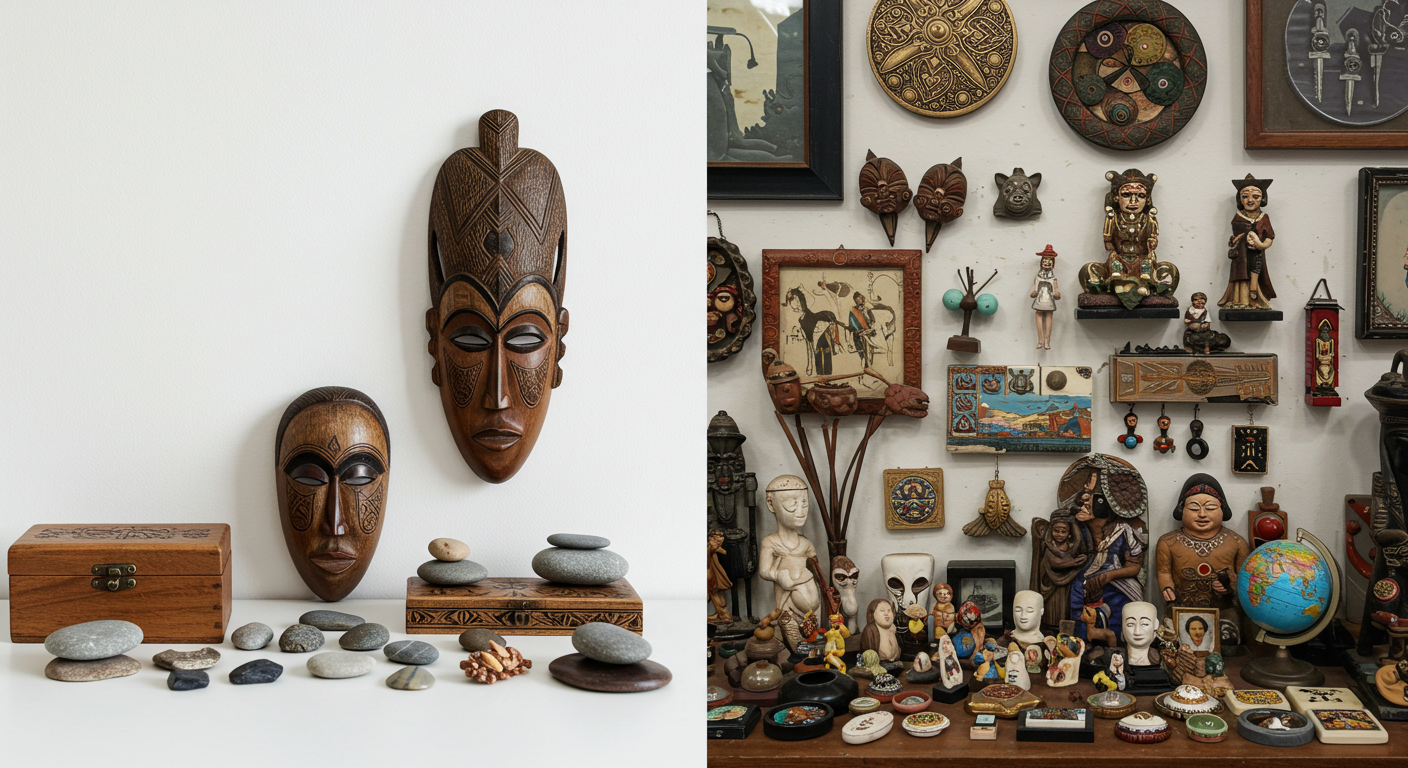
The secret to successfully incorporating travel souvenirs into your home lies in treating them as you would any other decorative object – with careful consideration for scale, placement, and overall aesthetic harmony. How to display travel souvenirs effectively means moving beyond the impulse to showcase everything you’ve collected and instead curating a selection that reflects both your adventures and your design sensibilities. When done thoughtfully, travel mementos become conversation starters that add personal meaning and global sophistication to your space.
The Art of Curation: Less is More
The biggest mistake people make when learning how to display travel souvenirs is thinking they need to showcase everything they’ve collected. Professional interior designers know that curation is key to creating sophisticated spaces that feel intentional rather than cluttered. The goal is to select pieces that work harmoniously with your existing decor while telling compelling stories about your travels.
Effective curation strategies:
- Choose quality over quantity – Select pieces that are well-made and visually appealing
- Consider scale and proportion – Ensure items fit appropriately within your space
- Look for design elements that complement your existing color palette and style
- Prioritize unique or meaningful pieces over mass-produced tourist items
- Rotate displays seasonally to keep your decor fresh and prevent visual fatigue
When I helped my sister redesign her apartment, we went through her extensive collection of travel souvenirs and selected only the pieces that met specific criteria: they had to be either beautiful objects in their own right, hold deep personal significance, or work within her modern minimalist aesthetic. The result was a much more sophisticated display that actually enhanced rather than distracted from her carefully chosen furniture and artwork.

Understanding how to choose a home decor style helps you make better decisions about which souvenirs complement your overall aesthetic vision.
Questions to ask when curating your collection:
- Does this piece add beauty to the space or just occupy it?
- Would I purchase this item for my home if it weren’t a souvenir?
- Does it complement my existing color scheme and style?
- Can it serve a functional purpose beyond being decorative?
- Does it spark joy and positive memories when I see it?
Creating Sophisticated Gallery Walls with Travel Memories
One of the most elegant ways to learn how to display travel souvenirs is through thoughtfully designed gallery walls that incorporate photographs, artwork, maps, and small memorabilia. This approach allows you to create a cohesive narrative about your travels while maintaining the sophisticated aesthetic that makes gallery walls so appealing.
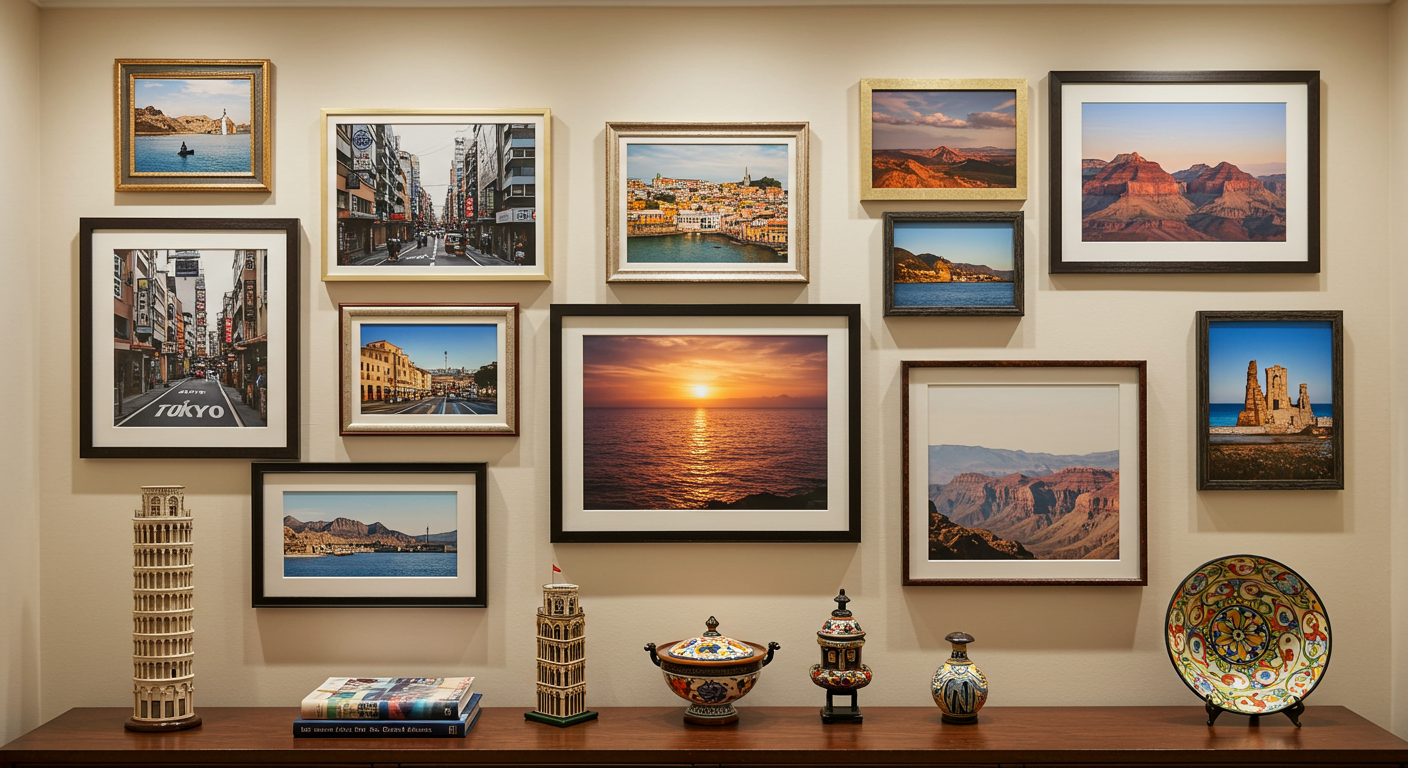
Gallery wall design principles for travel displays:
- Start with high-quality photographs as your anchor pieces
- Include maps from destinations you’ve visited, either vintage or artistically rendered
- Frame postcards and tickets in matching frames for visual cohesion
- Add dimensional elements like small shadow boxes with meaningful objects
- Maintain consistent spacing between pieces for a professional look
The key to successful travel gallery walls is treating them like any other sophisticated art display. This means investing in quality frames, planning your layout carefully, and ensuring that every element contributes to the overall aesthetic rather than competing for attention.

Frame selection guidelines:
- Choose a consistent frame style throughout the display
- Use museum-quality matting for photographs and paper items
- Consider metallic frames in brass or silver for a more upscale look
- Invest in UV-protective glass to preserve your memories
- Mix frame sizes thoughtfully to create visual interest
Learning about gallery wall ideas provides the foundation for creating travel displays that look professionally designed rather than haphazardly assembled.
📹 Expert Gallery Wall Guidance
For professional tips on creating sophisticated gallery walls:
– Julie Khuu provides expert advice on incorporating meaningful objects into your home decor.
Styling Travel Objects on Shelves and Surfaces
Learning how to display travel souvenirs on shelves, mantels, and other surfaces requires understanding the principles of professional styling. The goal is to create vignettes that look intentional and sophisticated rather than random collections of objects that happen to be from the same trip.
Professional styling techniques:
- Use the rule of thirds when arranging objects on shelves
- Vary heights and shapes to create visual interest
- Leave negative space to prevent overcrowding
- Group items in odd numbers for more dynamic compositions
- Layer objects at different depths for dimensional appeal
When styling travel souvenirs, treat them as you would any decorative objects. This means considering their form, color, and texture as design elements first, with their origin as a meaningful but secondary consideration. A beautiful ceramic bowl from Morocco should be displayed for its aesthetic value as much as its sentimental worth.
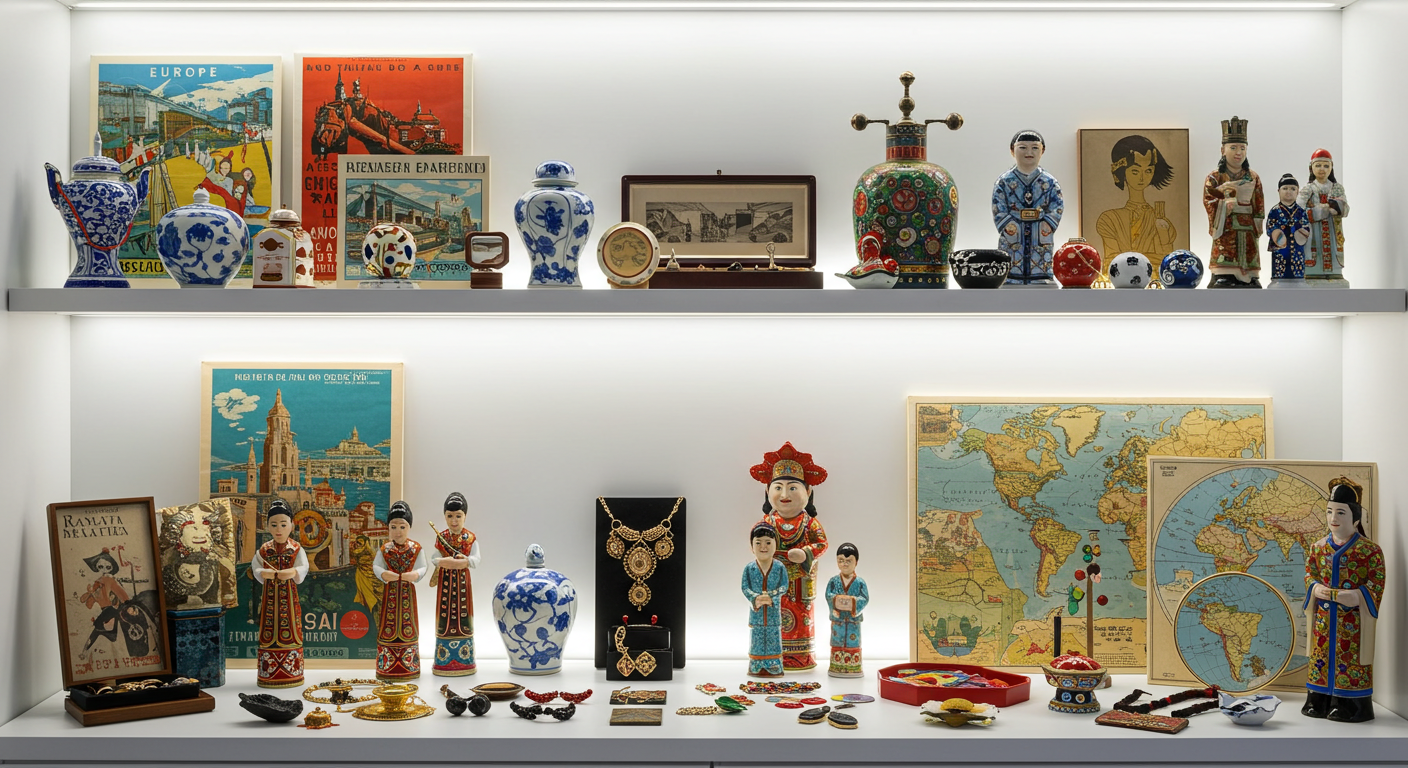
Creating cohesive shelf displays:
- Start with larger anchor pieces and build around them
- Add books related to your destinations for context and height variation
- Include plants to add life and freshness to static displays
- Use lighting to highlight special pieces and create ambiance
- Incorporate functional items like beautiful serving pieces or textiles
The intentional clutter style approach helps you understand how to arrange multiple objects in ways that feel curated rather than chaotic.
Incorporating Textiles and Functional Items
Some of the most sophisticated ways to learn how to display travel souvenirs involve incorporating textiles and functional items that you can actually use in your daily life. This approach ensures that your travel memories become integrated into your lifestyle rather than merely decorating your walls.
Textile integration ideas:
- Layer vintage scarves as table runners or wall hangings
- Use beautiful blankets from your travels as throws on sofas or beds
- Display handwoven baskets for both storage and visual appeal
- Frame textile samples like embroidery or traditional patterns
- Incorporate rugs that reflect the places you’ve visited
Functional souvenirs often make the most successful decor because they serve a purpose beyond being decorative. A beautiful cutting board from Tuscany, artisanal pottery from Mexico, or handwoven placemats from Guatemala can be both useful and beautiful, adding authenticity to your space without feeling like obvious tourist items.

Functional souvenir display strategies:
- Use beautiful serving pieces for entertaining
- Display vintage barware from different regions
- Incorporate unique lighting like lanterns or candles from your travels
- Show off artisanal dishes as part of your everyday table setting
- Use handmade storage containers for organizing with style
Shadow Boxes and Display Cases for Small Items
When you have small souvenirs that might get lost among larger decorative items, shadow boxes and display cases provide an elegant solution for how to display travel souvenirs while keeping them organized and protected. This approach works particularly well for items like jewelry, coins, shells, or other small collectibles.
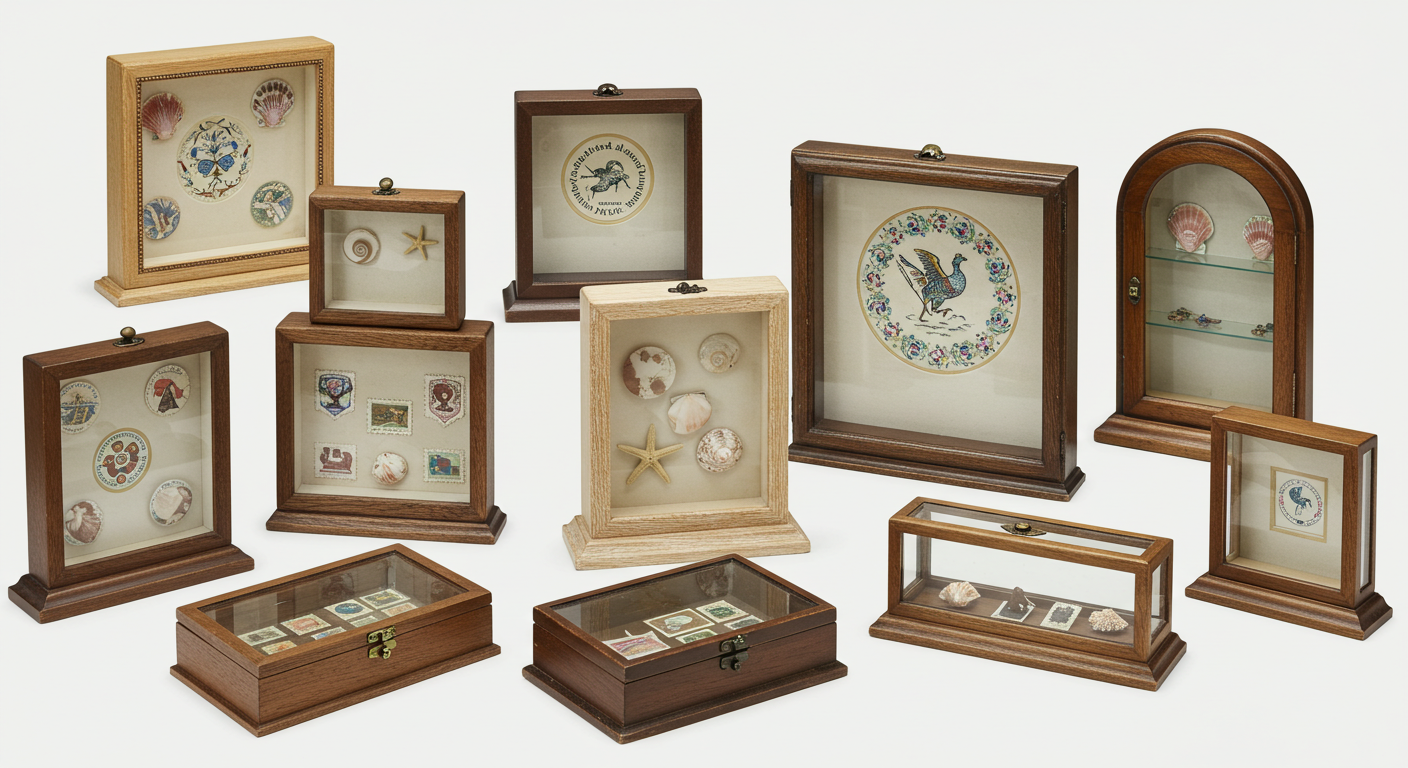
Shadow box design principles:
- Choose high-quality frames that match your decor style
- Use neutral background materials like linen or high-quality paper
- Arrange items with plenty of white space for a clean, uncluttered look
- Include small labels with locations and dates for context
- Group related items thematically rather than chronologically
The beauty of shadow boxes is that they transform small, potentially insignificant items into curated art pieces. A collection of vintage buttons from European markets, shells from different beaches, or traditional jewelry pieces can become sophisticated wall art when properly framed and arranged.
Display case considerations:
- Invest in quality cases with good lighting
- Rotate displays seasonally to keep them fresh
- Use museum-quality mounting materials to preserve items
- Consider humidity and temperature for delicate items
- Keep displays focused on specific themes or regions
Avoiding Tourist Trap Aesthetics
The key to successfully learning how to display travel souvenirs lies in understanding what makes some displays look sophisticated while others appear cluttered or cheap. Tourist trap aesthetics typically involve overwhelming quantities of obviously mass-produced items displayed without consideration for overall design principles.
Common tourist trap mistakes to avoid:
- Displaying everything at once without curation or editing
- Using obviously cheap or kitschy items as prominent decorative elements
- Ignoring scale and proportion when placing items in your space
- Clustering all travel items together instead of integrating them throughout your home
- Choosing quantity over quality when selecting which items to display
Instead, focus on selecting pieces that could stand on their own as beautiful objects, regardless of their origin. A hand-thrown ceramic vase from a local potter in Santorini should be displayed because it’s a beautiful vase, not just because it’s from Greece.

Understanding ethnic home decor ideas helps you appreciate how cultural objects can be incorporated authentically and respectfully into contemporary design schemes.
Creating sophisticated travel displays:
- Edit ruthlessly to include only your most meaningful and beautiful pieces
- Invest in quality display materials like proper frames and lighting
- Integrate items throughout your home rather than creating one “travel room”
- Focus on craftsmanship and artistry when selecting pieces to display
- Consider the overall narrative you want your decor to tell
📹 Professional Styling Tips
For sophisticated souvenir styling:
Cityline provides expert guidance on incorporating travel mementos stylishly.
Seasonal Rotation and Storage Solutions
An often-overlooked aspect of learning how to display travel souvenirs effectively is developing a system for rotating displays and storing items that aren’t currently on show. This approach allows you to enjoy your entire collection while preventing your space from becoming overcrowded.
Benefits of seasonal rotation:
- Keeps displays fresh and prevents visual fatigue
- Allows you to enjoy more of your collection over time
- Reduces clutter while maintaining sentimental connections
- Provides opportunities to rediscover forgotten pieces
- Enables seasonal storytelling through your decor choices
Consider creating themed rotations based on seasons, colors, or types of trips. Summer might feature beach finds and bright textiles, while winter could showcase cozy items from mountain destinations or European cities.
Storage organization strategies:
- Use acid-free boxes for delicate items
- Label everything clearly with location and date information
- Photograph arrangements before storing to remember successful displays
- Store textiles properly to prevent damage from insects or moisture
- Keep an inventory of your collection for easy reference
The affordable home decor approach can help you create beautiful displays without investing heavily in expensive storage and display solutions.
Integrating Travel Finds with Existing Decor Styles
Successfully learning how to display travel souvenirs requires understanding how different types of objects work within various decorating styles. What looks perfect in a bohemian-style home might appear out of place in a minimalist space, and vice versa.
Style-specific integration strategies:
Modern/Minimalist homes:
- Choose clean-lined pieces with simple forms
- Focus on quality over quantity with very selective displays
- Use neutral backgrounds to highlight colorful or textured items
- Integrate functional pieces that serve a purpose beyond decoration
Traditional/Classic interiors:
- Display items in established collections with other similar objects
- Use formal arrangements with symmetrical compositions
- Choose pieces with historical significance or classical beauty
- Frame items properly with museum-quality materials
Bohemian/Eclectic spaces:
- Layer different textures and patterns from various cultures
- Create abundant displays that tell rich stories
- Mix high and low pieces for authentic collected-over-time appeal
- Use color boldly to unify disparate elements
Understanding interior design styles helps you make informed decisions about which travel souvenirs will work best within your existing aesthetic framework.
Universal integration principles:
- Consider color harmony between souvenirs and existing decor
- Respect scale relationships within your space
- Maintain visual balance throughout room compositions
- Honor your personal style while remaining open to new influences
Creating Meaningful Vignettes and Conversation Starters
The ultimate goal of learning how to display travel souvenirs is creating displays that spark conversations and share stories about your experiences. Well-designed vignettes featuring travel mementos become natural focal points that invite guests to ask questions and engage with your memories.
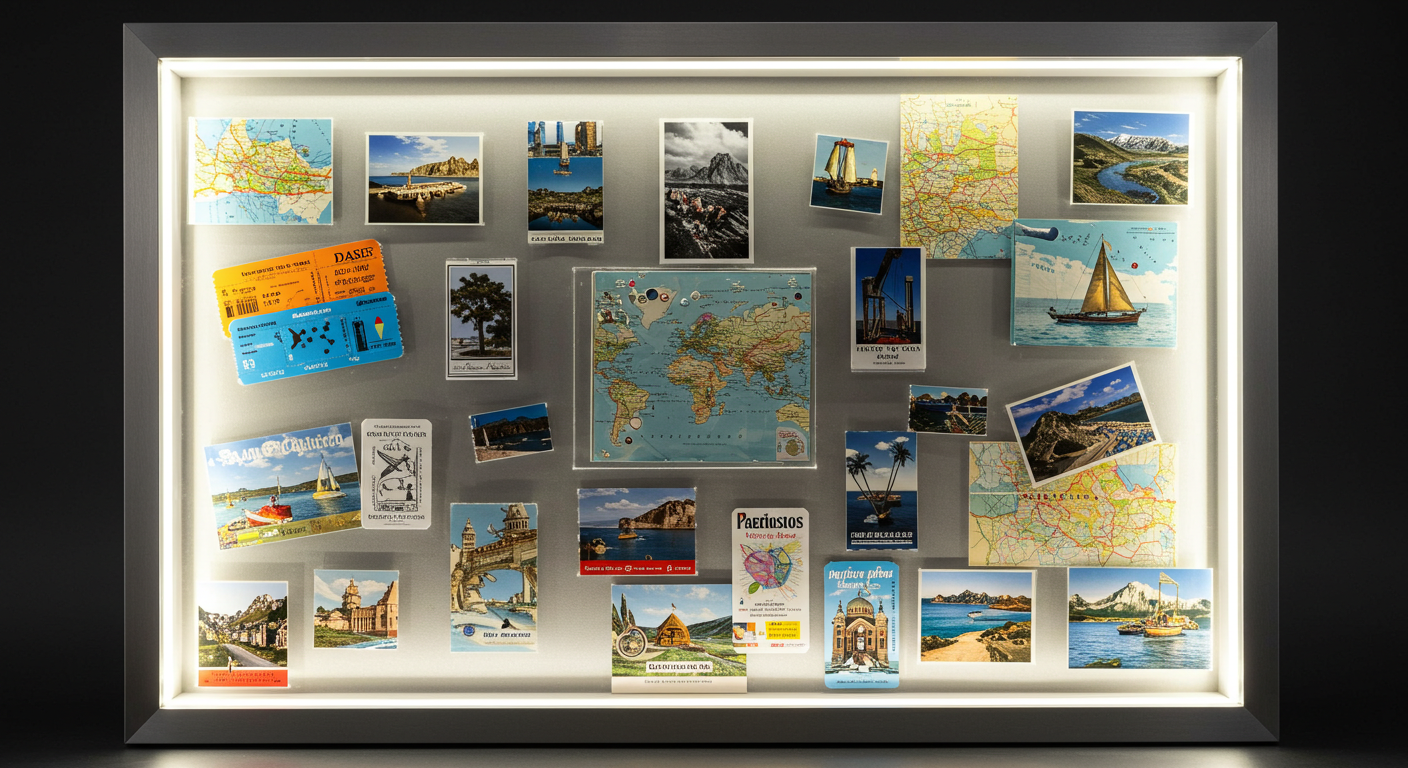
Elements of successful travel vignettes:
- A focal point piece that draws the eye and anchors the display
- Supporting objects that enhance rather than compete with the main item
- Contextual elements like books or maps that provide background information
- Personal touches like handwritten notes or photographs
- Varied textures and heights that create visual interest
Consider creating small vignettes that tell specific stories – perhaps a corner dedicated to your honeymoon in Tuscany with wine-related items, vintage postcards, and a small olive oil bottle, or a bookshelf arrangement featuring objects from a memorable solo trip to Japan.
Storytelling through display:
- Group related items to create narrative cohesion
- Include documentation like photos or journal excerpts
- Add explanatory elements without over-labeling
- Create emotional connections through thoughtful pairing
- Update displays as your travel story continues to evolve
The minimalist home decor philosophy can inform your approach to creating impactful displays with fewer, more carefully chosen elements.
Maintenance and Preservation of Travel Displays
Once you’ve mastered how to display travel souvenirs effectively, maintaining their appearance and preserving their condition becomes important for long-term enjoyment. Proper care ensures that your meaningful objects continue to look beautiful and tell their stories for years to come.
Preservation best practices:
- Dust regularly with appropriate materials for different surfaces
- Protect from direct sunlight which can fade colors and damage materials
- Monitor humidity levels especially for organic materials like wood or textiles
- Handle carefully when rearranging or cleaning displays
- Address damage promptly to prevent further deterioration
Different materials require specific care approaches. Textiles may need professional cleaning, metals might require polishing, and ceramics should be handled with extra care to prevent chips or cracks.
Seasonal maintenance routines:
- Deep clean display areas during seasonal rotations
- Inspect items for signs of damage or deterioration
- Update protective measures like UV-filtering glass or humidity controls
- Reorganize storage areas to prevent overcrowding and damage
- Document condition changes for insurance or sentimental purposes
Regular maintenance not only preserves your objects but also provides opportunities to rediscover forgotten pieces and reorganize displays for maximum impact.
Learning how to display travel souvenirs without creating tourist trap decor is ultimately about applying good design principles to objects that hold personal meaning. By curating carefully, displaying thoughtfully, and integrating your travel finds with your existing aesthetic, you can create sophisticated spaces that tell your story while maintaining the elegant atmosphere you’ve worked to achieve. Remember that the best travel displays are those that enhance your daily life, spark meaningful conversations, and bring joy every time you see them. The goal isn’t to showcase every souvenir you’ve collected, but to create beautiful, intentional displays that honor both your adventures and your design sensibilities.




